
Luger P08 Artillery - Tanaka
If there is one gun which is universally known worldwide, it is probably the Luger.
Used throughout both world wars by German forces and widely prized as a trophy by the allies, it also sold in considerable numbers commercially, throughout the 20th century, in numerous calibres and barrel lengths (and even as a Carbine).
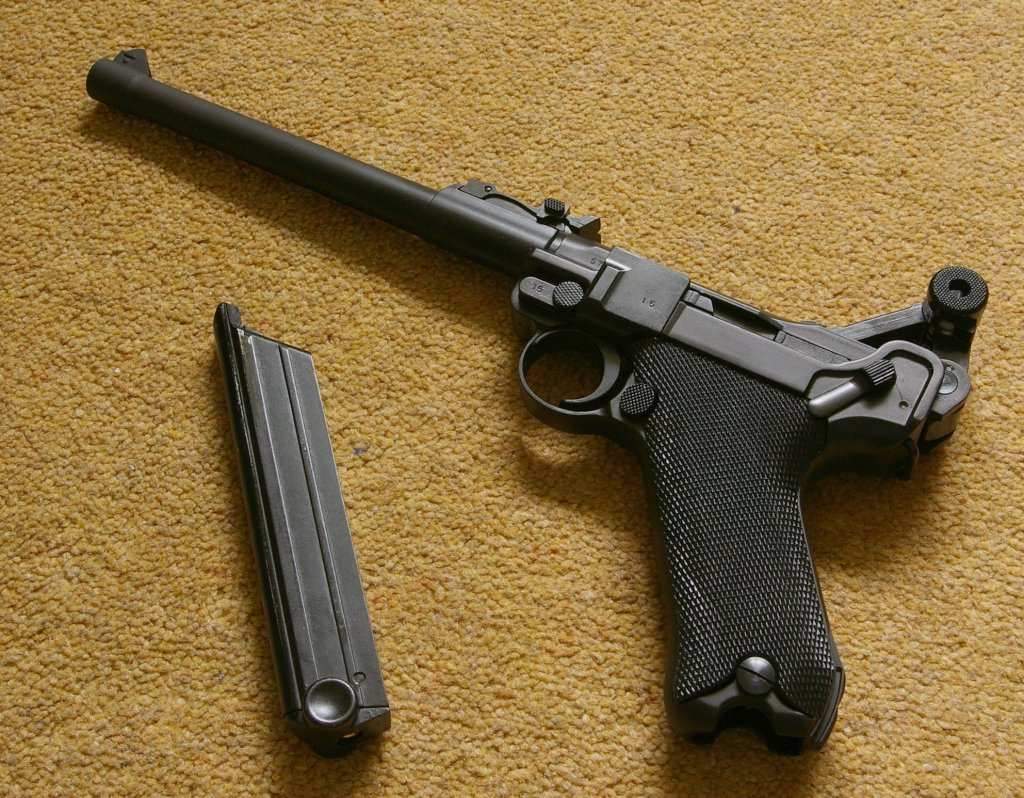
I had looked into buying used Tanaka Lugers a few times, but when an 8" barrelled Artillery model appeared, as part of a new range of 'heavyweight' models, I quickly placed an order with my favourite HK retailer, Guns N Guys.
In 3 days, the package was here, but the expectation was raised further due to me being unable to check out the contents for a further 3 days!
In the Box
The box is formed of a glossy cover (with a green background) featuring a photograph of the Tanaka P08 Artillery and a polystyrene base, with "P08" cut into it.
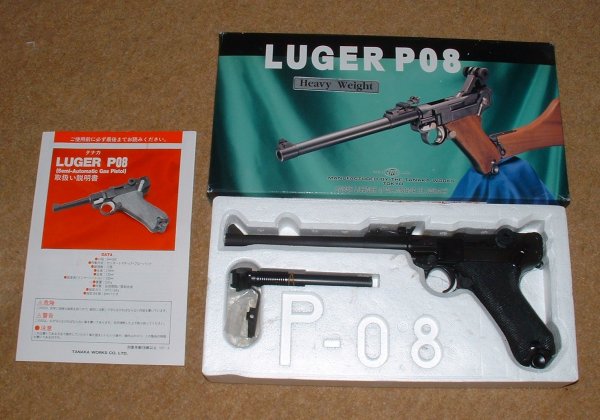
There is a cut-out for the barrel of a 6" or 8" (Navy or Artillery) version of the Luger and a small cut-out at the bottom, which holds a few BBs, a hex key for the Hop-Up and a replica of the take down tool (although, bizarrely, it is about 1/4 scale to the real thing!)
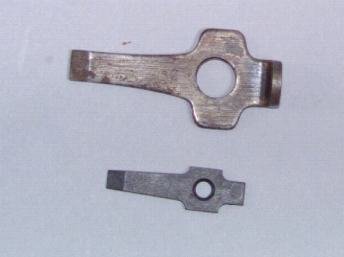
As well as the gun, BBs and tools, there is a fairly clear (but all Japanese) manual.
First Impressions
I found it hard to be completely dispassionate about the Luger. This is, probably, THE classic gun in my mind, but the all black gun lying in the box did not disappoint at first sight.
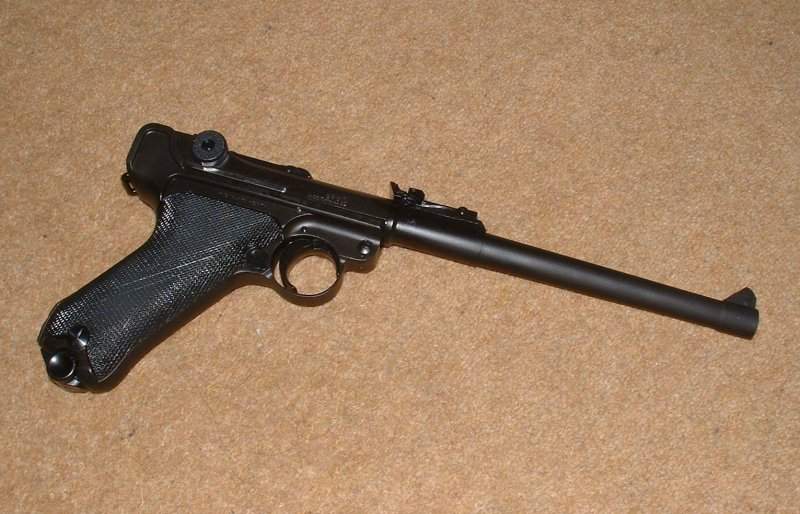
Being Heavyweight, the gun is made of a matt plastic (It's the same kind of material as used on Heavyweight slides by Western Arms and KSC and by Marushin on some revolvers and automatic NBBs) and looks very solid. The gun is not very heavy, but being slender it does not feel overly light when you pick it up and the balance feels very good.
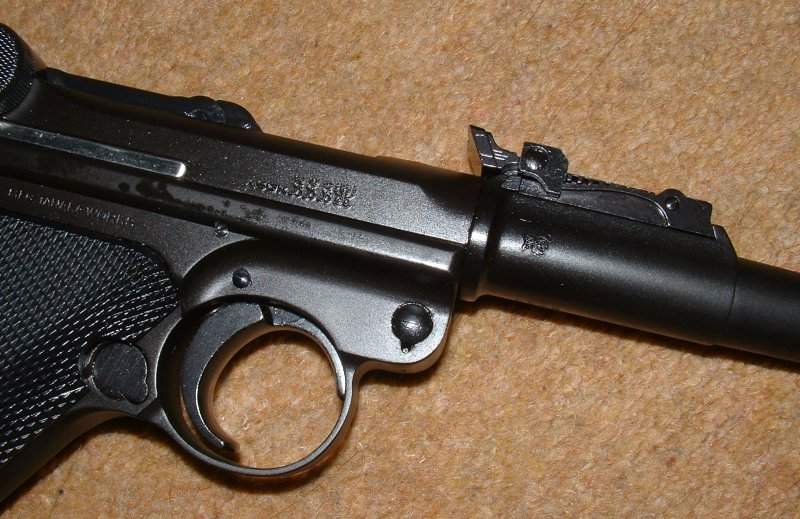
Markings and general finish all look good and features like the adjustable rear sight (on the barrel), the safety, new moon trigger, grips (black plastic, more on that later), magazine and the distinctive toggle system are all faithfully replicated.
Closer Look
There is one niggle with the latest Tanaka Luger Artillery. The gun reproduced is a 1915 version. Guns of this vintage would have had wooden grips. Now, it is not beyond belief that a Luger would have received black plastic grips (from later guns) over the years and Tanaka also make a set of real wood grips, but, for purists (and I am not one to this extent) this might grate. Still, there is a case to make for black plastic versus fake wood grips (see the Marushin Mauser!).
Equally, early Lugers had magazines with wooden bases and Tanaka has not tried to replicate this in anyway. Again, a few might find this a limitation, but given the nature of gas magazines, neither real wood nor plastic would have been a great choice for this fragile area of the magazine.
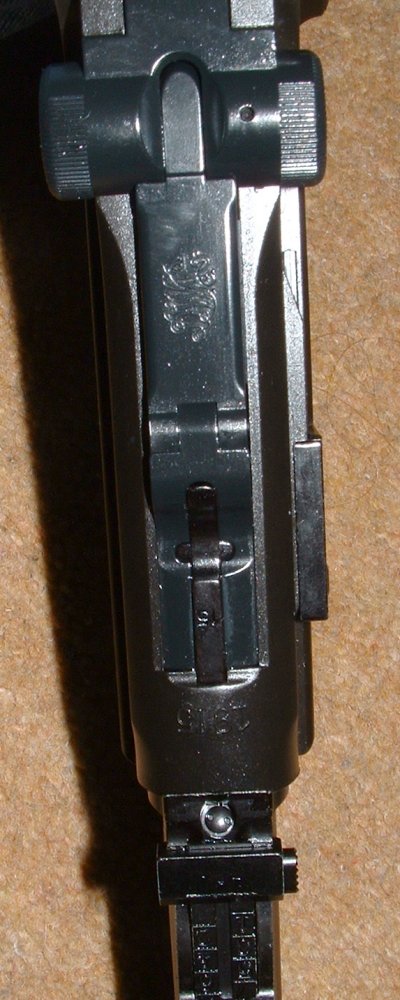
Aside from that, though, faults are hard to find. Tanaka have made sure that all the proofing and serial markings (15 on all the parts, this is important, as real Lugers are so finely engineered that parts for one gun may not work on another) are present, and correct, for the 1915 vintage P08 Artillery Luger. Details like the visibility of the word Gesichert (Safe) when the safety is engaged and the small metal tab (with its 15 serial number) that raises when the safety is engaged, make the Tanaka Luger a joy to revisit over and over, even without pulling the trigger!
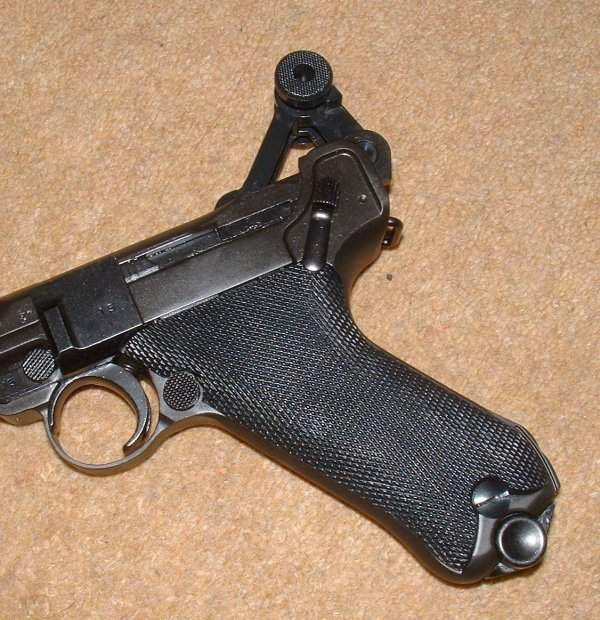
What really makes the Tanaka Luger a 'must have' for airsoft enthusiasts, is that unique toggle action. Each time the trigger is pulled the breech is pushed back and pushes the toggle up. Because, of course, there is not a lot of weight in the small toggle mechanism, even though it is metal, the Luger fails to deliver the perceived recoil of some other powerful GBBs, but the plus side is in the ability to keep the gun on target.
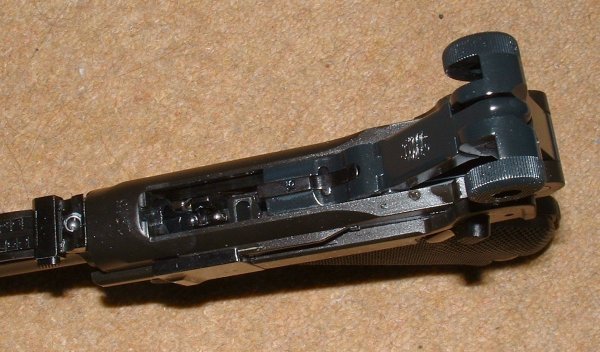
Markings abound on the Luger and I continue to find small markings I had previously overlooked, but, as far as I can tell, the markings present are as follows.
On the left side of the frame there is the word Gesichert (Safe), which is only visible when the safety is pushed down (to safe the gun). On the trigger plate there is a 15, which is also present on the breech, on the disassembly lever and on the small tab which rises on the side of the frame, when the safety is engaged.

On the barrel top, there is the date 1915 and a DWM (Deutsche Waffen Und Munitionfabriken) works mark on the top of the toggle action.
On the right side of the frame, there are numerous proofing marks and the legend "MFG TANAKA WORKS" with proofing marks on the upper receiver, along with a fairly discrete ASGK mark.
Under the barrel, there is the marking "5715", which is also on the frame, just ahead of the trigger plate and repeated under the barrel on the front of the frame.
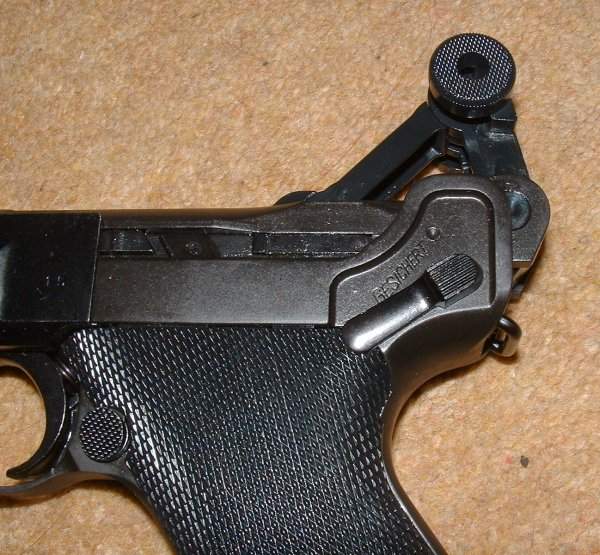
The Artillery sights are present on the rear of the barrel. These are metal and adjustable for range, using a sliding notch which moves along a graduated scale base.

The magazine is released by a standard looking button on the left side of the frame, behind the trigger (which is crescent shaped, as you would expect of a quality Luger replica). Interestingly, many later European designed guns, including the Walther P38 which replaced the P08 as Germany's standard sidearm, dispensed with this design and put a simple catch on the base of the grip, a design which is almost extinct now.
The magazine itself is slender, with the trademark circular finger pulls at the bottom. The Luger uses a licensed WA Magna R system, although there is no sliding catch on the top valve (as you would see on WA magazines) and, so far, I have seen no sign of gas leaks from any of my 3 magazines, although earlier Tanaka Lugers (It is said there have been 3 different magazine designs, at least!) have a terrible reputation for developing unresolvable leaks in the bases.
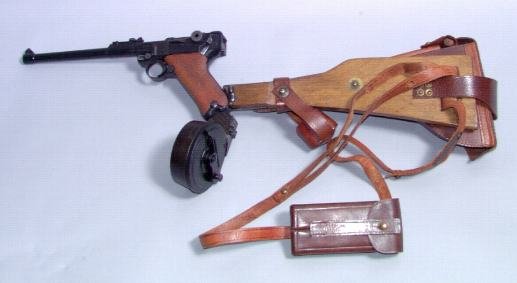
One owner, who also bought the Tanaka wooden stock and grips has commented that extended use of the stock can break off the lug which secures it to the pistol's grip and that the wood grips do not clear some of the workings and are too fragile to file for clearance.
One thing that is noticeable is how good a design the Luger, revised from the Borchardt, is. The angle, and width, of the grip is just right and the fine sights are easy to use.
The Luger was (and is) a prized gun because of its high quality and precise engineering. This high degree of tolerance did mean that it was not so tolerant of dirt and neglect and I suspect that will be equally true of the Tanaka airsoft version. However, that shouldn't discount the gun from use as a skirmish sidearm. Simply ensure that you lavish upon it the care it deserves.
Shooting Impressions
To be honest, I wasn't expecting anything special from the Luger. I suppose the promise of a licensed Magna R Blowback system and an 8" barrel should have been a clue, but I was so happy with the excellence of the finish and the cycling action, that I sort of expected the gun to be a disappointment to shoot.
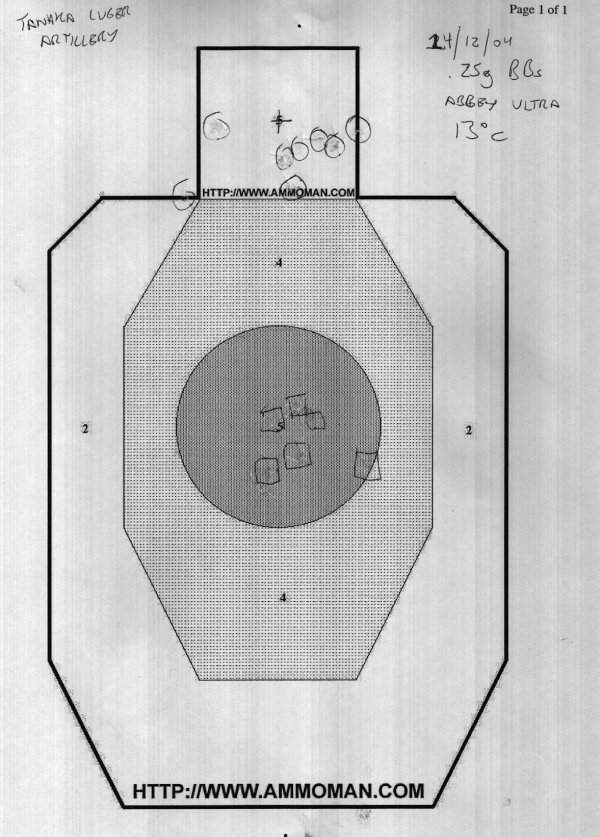
Click on image for bigger version in separate window.
Carrying out my standard 5m/6 round, off hand test, I achieved extremely good results. All 6 shots (the squares on the target above) fell into the centre, around the aim point. The best 5 were just 2.5 CM (1 inch) across.
So impressed was I, that aimed at the small head part of the target and fired off 8 shots. 7 hit the head (A 2x2 inch square), with the 8th just a fraction left. Best 5 here (the circles on the target above) was 1.75 CM (3/4 inch) across.
The very fine sights make it easy to aim accurately, but this accuracy matches the very best I have recorded.
Over 10 shots, the Artillery Luger averaged a highly impressive 312 fps (using Abbey Ultra gas) indoors (at 10C).
| Shot | FPS |
| 1 | 330.5 |
| 2 | 331.1 |
| 3 | 321.0 |
| 4 | 321.1 |
| 5 | 305.3 |
| 6 | 289.3 |
| 7 | 303.8 |
| 8 | 295.7 |
| 9 | 304.3 |
| 10 | 318.9 |
So, with the long barrel, fine sights, comfortable grip action and (a negative for some, I know) the gentle kick, the Tanaka Artillery Luger is an impressively powerful and accurate airsoft pistol, easily the match of anything else I have tested.
The video below shows a Tanaka Luger being fired, to give you an idea of what the action is like. Note how the barrel moves back as the gun is fired.
Trigger pull is medium/heavy for a GBB at around 53 Ounces (1500g).
Take Down
Unsurprisingly, Tanaka have replicated the take-down accurately. However, to anyone used to Browning designs (like the 1911) or Berettas, the process is not a little complex. However it is worth bearing in mind that the basic design goes back to the late 19th century!
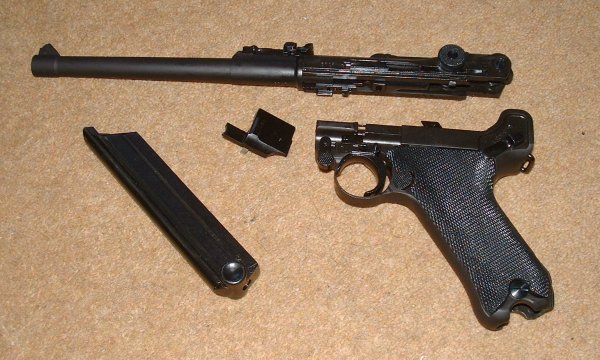
With the magazine removed and the safety engaged, push the barrel back slightly and move the takedown lever on the frame, down from the rear, where there is a chequered 'button' on the lever (this was very tight on my gun, at least initially).
With this down, you can remove the trigger panel (the flat piece above the trigger) and then the whole barrel and receiver can be slide forward off of the frame.
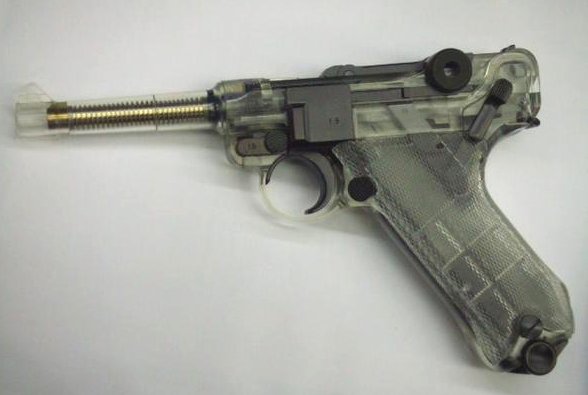
Having done this a couple of times, it is certainly not as easy as with a Browning design automatic, but full marks to Tanaka for taking the trouble to get it right.
This page, from Marstar, explains the process (The subsequent page relates to the real thing ONLY, as the internals are, obviously, different).
Conclusions
Overall, the Tanaka P08 Artillery Luger is a true classic.
Some will bemoan the lack of a fierce kick, but with the design as it is, there is little Tanaka could have done to improve this.
Aside from the fact that it is really not that heavy (and those black grips), the gun is a great replica of a Luger and the sight of that toggle action working as the gun fires never ceases to surprise and delight.
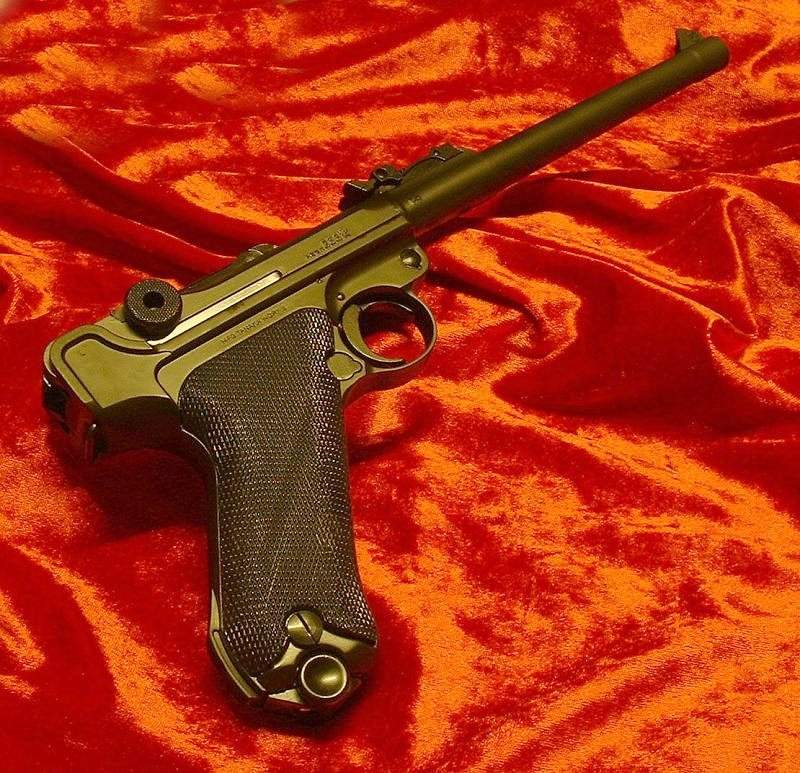
Couple that with supinely good power and remarkable accuracy and you have a pistol worthy of a place in any airsoft collection.
It is no exaggeration to say that this gun has become my instant favourite.
Update/Warning
CatchV22 from Arnie's Airsoft dropped me this message, which is worth reading if you own a Luger - Better safe than sorry!
Well, it seems both ZenMastaT and I have had the same problem with our Luger: the firing pins. It seems that the firing pin doesn't retract
when inserting a new magazine (when the hammer is down and firing pin forward) so many new users may force the magazine in and break the
firing pin.
Also, prolonged dry firing (with the magazine inside the gun) seems to shatter the firing pin as well.
I hope you can include these revisions in your reviews to warn others about what I still think is a great airsoft pistol.
Weight : 730g
Realism : *****
Quality : ****
Power : *****
Accuracy : *****
Real Steel link at World Guns
Lyn Haywood's review on Arnies Airsoft
For anyone wanting to know more about Lugers, the HLE e-books
provide excellent information at a very reasonable price.
Gun World's extensive Luger section
The Borchardt - The original semi-auto
handgun, from which the Luger is derived.
Marstar in Canada - Sell reproduction leather holsters and other parts.
Back to the Homepage